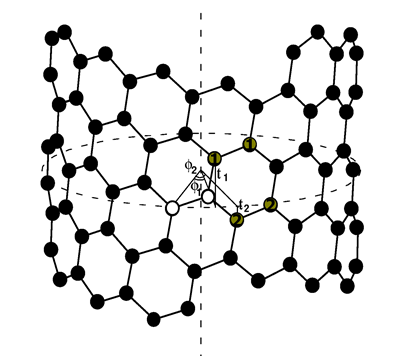Optimized structure of
single-walled carbon nanotubes (SWNTs)
|
|
A nanotube can be obtained by cutting an
infinite strip of a graphene sheet (Fig. 1) perpendicular to the chiral
vector Ch = L1a1 + L2a2
= (L1,L2), through its beginning
and end points, O and O', and folding the strip into a seamless cylinder. The
nanotube is uniquely specified by the pair of integers (L1,L2). Alternatively, the nanotube can be
specified by its radius R = Ch/2π and the chiral angle θ
(the angle between the chiral vector and the nearest zigzag of carbon-carbon
bonds). R and θ are given by the following relations
The nanotube has a translational periodicity
with primitive translation T = (N1,N2). The unit cell
of the nanotube contains N carbon
pairs. N1, N2, T, and N are given by the relations
where d is the greatest common divisor of 2L1 + L2 and L1 + 2L2. The nanotube has helical symmetry similar to the translational symmetry of graphene. Namely, graphene can be constructed by linear combinations of the two primitive translations of a given carbon pair. Similarly, a nanotube can be constructed by linear combinations of two screw operations executed on a carbon pair. A screw operation {S|t} consists of a rotation at an angle φ about the tube axis and a translation at a vector t along the same axis (Fig. 2). The parameters φ and t are given by
There is an additional screw operation {S'|t'} coinciding one of the atoms of the carbon pair with the other, defined by the parameters φ' and t'
The folded tube structure should be relaxed.
Assuming conservation of the cylindrical geometry of the tube, the number of
independent parameters can be as low as four. A suitable set of such
parameters is the following one [1,2]
The relaxed values of these parameters,
obtained within a non-orthogonal tight-binding model, are discussed in Refs.
[1,2] and are available for download. References: 1. V. N. Popov, New J. Phys. 6 (2004) 1-17. 2. V. N. Popov and L. Henrard, Phys. Rev. B 70 (2004) 115407. |
|
|
Valentin Popov


